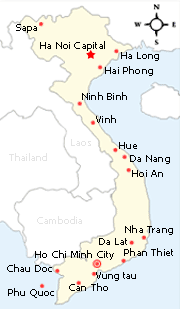|
In God’s Country Administratively speaking, the province of Dien Bien was created in early 2004 from the southern area of the former Lai Chau province (north of the Da River) and the town of Dien Bien.
Dien Bien Phu is now a modern and historical place with a blend of administrative buildings, modern hotels and cultural or historical sites, surrounded by a cluster of ethnic Thai villages. Tourists can enjoy home-stay accommodation there in a wonderful way to discover the Thai culture. On our first night, my friends and I stayed at a private guest-house in the centre, but next day we decided to visit Men village, just 5km away. The village is full of traditional Thai stilt-houses. It’s a charming and tranquil spot to enjoy fresh air and the whisper of the nearby stream. The place is actually a more modern creation-I would prefer the truly rustic experience offered by a simple stilt-house with a thatched roof and a bamboo screen floor. Accommodation costs VND150,000 per night and includes a meal of sticky rice cooked in a bamboo basket, com lam (grilled sticky rice), boiled vegetables, dried buffalo and grilled pork, chicken or fish. Thai people from Dien Bien cook the most delicious rice I have ever tasted. You might also be treated to local delicacies such as roasted bees or chicken. Thai beliefs The Thai believe in Muong Con (the land of the living), Muong Phi (the land of the dead) and Muong Then (the land of God). Dien Bien province, where 40 percent of the population is estimated to be ethnic Thai, is God’s country as here you will find the valley of Muong Then. According to a Thai legend, God (Then) created human beings in a gourd, which he punctured with a pin to release the humans onto the earth. The first people to emerge from the gourd were the Xa. They were followed in turn by the Thai, the Lao, the Lu, the Mong and finally the Kinh (the Vietnamese ethnic majority). The gourd then became a mountain, which stands today in Tau Phung commune in the middle of the Muong Thanh valley. There are two main Thai tribes in Dien Bien province: Black Thai and White Thai, which you can distinguish from their head-dresses in black and white colour respectively. House rules Every town house has two sets of stairs-one on the left for men and one on the right for women but don’t worry if you forget which way to go. Thai people are very hospitable and easy going. You will often be asked to toast with alcohol during meals. I have learned through experience that Thai women can drink pretty well. Sure enough, one of my male friends, who is fond of a tipple, once had a few too many, then got pissed under the table. Those who manage to remain sober over dinner are then invited to watch a traditional dance performance by Thai girls around a fire. The dancing is known as Xoe. There are many different kinds, one called Kham khan moi lau, involving a handkerchief and betel nuts, intended to be used as a romantic dance and a way of showing hospitality. The dance known as Pha xi implies community solidarity and ancestral devotion. The Doi hon dance moves forwards and backwards, implying that human love is unshakable and faithful. The Nhuon khan dance is the most jubilant and is often performed after a good crop or at a wedding or house warming party. End of the evening At the end of the performance, everyone is invited to join in the Kham Khan dance where a large circle is formed. The dance signifies both community solidarity as well as a common wish for a happy and prosperous life. Everyone dances hand in hand around a wood fire creating a wonderful social and festive atmosphere. After a sumptuous meal with a few shots of liquor and an evening of dancing we all fall into a deep sleep on the brocade mats spread out across the bamboo floor despite the wind and the rain that has picked up outside. In the morning there is enough time to pick up some of the brocades and embroidered products which are all handmade by women in the village. This tradition trade is now part of the local tourism industry which helps the Thai communities prosper and retain their cultural identity. VietNamNet/Time-out
Other news for Sunday 03 January, 2010
View all news for Sunday 03 January, 2010 on one page News for Thursday 31 December, 2009
View all news for Thursday 31 December, 2009 on one page Recent News
|










